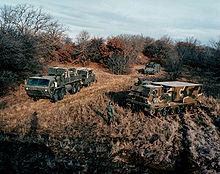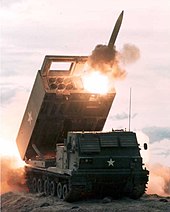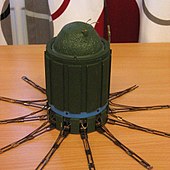Multiple launch rocket system
 MARS (MLRS) of the German Armed Forces |
|
| MLRS | |
|---|---|
| General properties | |
| crew | 3 (commander, driver, gunner) |
| length | 7.07 m (23 ft) |
| width | 3.25 m (9.9 ft) |
| height | 2.85 m (9 ft) |
| Ground clearance | 430 mm |
| Chain width | 530 mm |
| Weight | ~ 21 t (without ammunition and without on-board equipment) ~ 26 t (ammunition: bomblets ) ~ 25.5 t (ammunition: anti-tank mines ) |
| Armor and armament | |
| Armor | welded aluminum with armored laminated glass panes |
| Armament | Rockets with 227-237 mm, Cal. 298 mm * |
| Max. loading | 12 missiles |
| cadence | 12 rockets, one rocket each 5.5 s |
| ammunition | Bomblet missile M77 Mine missile AT-2 Training missile M26, GMRLS, UNITARY, 110 mm LAR |
| agility | |
| drive | V8-cylinder four-stroke CUMMINS diesel with 368 kW (500 PS), direct injection and exhaust gas turbocharger |
| suspension | Torsion bar suspension and vibration damper |
| Brakes | oil-cooled multi - disc brake |
| Top speed | 56 km / h (35 mph) or 65 km / h mechan. regulated |
| Strength / weight | |
| Consumption road / terrain per 100 km | 150/280 l with 636 l tank capacity |
The Multiple Launch Rocket System ( MLRS ) is a multiple rocket launcher - artillery system on a tracked chassis. The type designation of the American military is M270 . It is used by the Bundeswehr under the name of the Medium Artillery Missile System ( MARS ). During the Cold War , the comprehensive use of MARS I against tank formations of the Warsaw Pact was planned.
description
The weapon system consists of a horizontally and vertically pivoting launcher frame with an electronically controlled hydraulic aiming drive (Electric Launch Drive System; ELDS). With MARS I with a slower electro-hydraulic drive. Six rockets each are stored, transported and launched from the 2.5-ton container-like transport and launch containers ( Rocket Pod Containers , RPC). When launching, the rocket needs at least 5 tons of thrust to release from its mounts in the RPC. It is guided with sliding blocks (projectile guide mechanism inside the launch tube) to the tube outlet. The rocket launch containers (RPC) can be easily picked up, loaded and set down using a loading and lifting device integrated in the launcher frame. One operator is enough to carry out quick loading and unloading.
Main chassis assemblies are from the M2 Bradley infantry fighting vehicle ; A driver's cab with three seats for the driver, the operator of the fire control system (rocket gunner) and the commander (thrower operator) is mounted on it. The 368 kW engine from Cummins Engine has an automatic transmission with three forward gears and one reverse gear. This combination with the torsion bar sprung support roller drive with live end connector crawler enables the MLRS to travel at speeds of over 70 km / h. With the MARS, the German transmission only allows 65 km / h, the DC 129 C1 chain only 50 km / h.
The American M142 High Mobility Artillery Rocket System (HIMARS) is a lighter carrier system on a wheeled vehicle and equipped with six rockets or an MGM-140 ATACMS ; it is based on the M270 MLRS.
armed forces
The rocket artillery the army is divided with eight launchers each battery. It fires the AT2 anti-tank mines with the MARS over distances of around 10 to 38.5 kilometers. The originally procured M77 bomblet missile, as cluster munitions, is subject to the mine ban of the Anti-Personnel Mine Ban Treaty ( Ottawa Convention ) and the Convention on Cluster Munitions . For training purposes, the M28 caliber rocket and the 110-millimeter rocket of the Lars weapon system can be fired from modified rocket launch containers (see below).
From 1989 to 1993 158 MARS, including 4 driving school vehicles and 9,360 rockets with 262,080 AT-2 mines, were procured for the German Armed Forces.
MARS II
With the product improvement (PV) MARS II while retaining the previous carrier system and the procurement of the M31 Guided Multiple-Launch Rocket System (GMLRS) with a speed of Mach 3.4, a distance capability of around 84 km and a precision capability are achieved for the first time significantly contributes to the reduction of collateral damage . The range of 100 km was exceeded by far on several test bases. These are modified warheads with which it is possible to set the nominal or vertical approach angle of the missile. With a range of 84 km, a hit accuracy (CEP) of 7 meters could be achieved. The range increase to up to 140 km is planned. The renewal of the MARS equipment includes a laser gyro system and a further technical development of the GPS navigation system, which is known as an Explosion Resistant GPS Receiver (ERGR) and is the successor to the Precision Lightweight GPS Receiver (PLGR) customary in the armed forces . In addition, the drive of the weapon system was converted from an electro-hydraulic to an electric directional drive, the Electric Launch Drive System (ELDS) . As a result, the straightening speed was increased and loading and unloading was accelerated by up to 60 percent compared to MARS I.
Search fuze ammunition for artillery (SMArt) and a penetrating fragmentation / warhead (unitary) will be used as warheads . This includes delay fuses and proximity fuses.
The first MARS II system was handed over to the Artillery School in Idar-Oberstein on April 6, 2011 . It contains more than 2300 new parts.
In 2012, the rocket artillery battalion 132 (RakArtBtl 132) in Sondershausen was the first unit to be equipped with MARS II. The unit was disbanded after a troop shooting in March 2013.
In April 2016, the 4th battery of Artillery Battalion 295 was equipped with the MARS II, which led to the reclassification from tank artillery to artillery battalion. Since 2015, the 3rd battery of artillery battalion 131 (formerly observation tank artillery battalion 131 ) in Weiden in the Upper Palatinate has been equipped with MARS II.
The most powerful version in the US arsenal, however, is the BAT ( B rilliant A nti-armor T echnology) submunition. One MLRS missile can carry two BATs. It uses acoustic and infrared sensors to locate its target and is autonomous in the sense that it is able to seek and fight the target on its own. Its dual guidance system also allows it to combat mobile targets in difficult conditions. After the target has been captured, the swiveling aerodynamic control surfaces are activated and it “sails” to the target until it detonates. Targets are, for example, moving tanks, mobile surface-to-surface missile launch pads, multiple rocket launchers, but also fixed and hardened targets. In the NATO alliance case, this ammunition can also be fired by German MARS, as they are based on an update platform. Another missile for the MLRS is the Army Tactical Missile ( ATACMS ) . This missile can cover ranges of up to 300 km without following a ballistic trajectory.
In December 2017, the Artillery Training Battalion 345 tested the M31 missile (GMLRS-U) with an 81.6 kg fragmentation warhead together with the Office for Army Development at the Vidsel test site in Sweden with MARS II and fired twelve missiles.
Missiles
- M26 : rocket with 644 M77- shaped charge - bomblets . Range 32 km.
- M26 (AT2): missile with 28 AT2 anti - tank mines with magneto . Range 38 km.
- M26A1 (MLRS-ER): missile with 518 M85 shaped charge bomblets. Range 45 km.
- M26A2 (MLRS-ER): Like M26A1 missile, but with 518 M77 bomblets.
- M27 : Training rocket for practicing handling.
- M28 : Training rocket with three smoke bodies instead of the bomblets.
- M28A1 : Training rocket with a flat rocket tip . This reduces the range of 9 km.
- XM29 missile with BAT or SADARM (self-targeting guided missile ). Prototype only.
- M30 (GMLRS-DPICM): missile with GPS guidance system and 404 M101 bombs. Range 84 km.
- M30A1: Like the M30 missile, but with a penetration warhead . Range 84 km.
- M31 (GMLRS-U): Like M30 missile, but with 81.6 kg fragmentation warhead. Range 84 km.
- XM135: Missile with a binary warhead for the chemical warfare agent VX . Development stopped.
- MGM-140 ATACMS : Version with two ATACMS short-range missiles .
The more cost-effective ammunition of the LARS system , which is still available in the Bundeswehr, can be launched from special rocket pod containers (RPC). The 110 mm caliber light artillery missile (LAR) has a range of six to seven kilometers. It must be loaded into the RPC by hand.
commitment
The first war deployment took place during Operation Desert Storm . There were further deployments during the Iraq war in 2003 and in the war in Afghanistan since 2001 in Afghanistan . By the end of October 2014, over 3000 guided M31 missiles had been fired during war missions.
User states

-
 Egypt - 26
Egypt - 26 -
 Bahrain - 9
Bahrain - 9 -
 Germany - 41
Germany - 41 -
 Finland - 22 systems acquired by the Netherlands in 2004
Finland - 22 systems acquired by the Netherlands in 2004 -
 France (13 systems in the "1 er régiment d'artillerie" in Bourogne)
France (13 systems in the "1 er régiment d'artillerie" in Bourogne) -
 Greece ( Greek Army ) - 36
Greece ( Greek Army ) - 36 -
 Israel - 48
Israel - 48 -
 Italy - 21
Italy - 21 -
 Japan ( Ground Self-Defense Forces ) - 99
Japan ( Ground Self-Defense Forces ) - 99 -
 Netherlands - 23 systems, 22 of which were sold to Finland in 2004 and one was on display at the Nationaal Militair Museum in Soesterberg
Netherlands - 23 systems, 22 of which were sold to Finland in 2004 and one was on display at the Nationaal Militair Museum in Soesterberg -
 Norway ( Den Norske Hær ) - no longer in use
Norway ( Den Norske Hær ) - no longer in use -
 South Korea - 58
South Korea - 58 -
 Turkey - 12
Turkey - 12 -
 United Arab Emirates
United Arab Emirates
-
 United Kingdom - 35
United Kingdom - 35 -
 United States - 385
United States - 385
See also
- LARS ( light artillery missile system )
- M4C2V (mobile command post)
Web links
- 60 seconds Bundeswehr: MARS-II rocket launcher (YouTube video, April 3, 2019)
- Accurate information (English)
Individual evidence
- ↑ MARS rocket launcher - YouTube. In: youtube.com. Retrieved May 16, 2019 .
- ^ Ralf Schulte: MARS (Bw). In: panzerbaer.de. Retrieved May 16, 2019 .
- ↑ Sebastian Kreutzkamp : Photo gallery: Last shot of the rocket artillery battalion 132. In: rk-instbtl7.de. April 26, 2013, accessed May 16, 2019 .
- ↑ Historic missile launch - Bundeswehr fires high-precision ammunition in Sweden - YouTube. In: youtube.com. Bundeswehr, December 7, 2017, accessed on May 16, 2019 .
- ↑ a b c The Royal Artillery tries again. In: ukarmedforcescommentary.blogspot.ch. UK Armed Forces Commentary, September 26, 2016, accessed March 2, 2017 .
- ↑ Armada International, Issue 2, April – May 2015: Compendium Artillery. 2015, p. 47.
- ↑ The Military Balance 2018, p. 330
- ↑ The Military Balance 2018, p. 328
- ↑ The Military Balance 2018, p. 108
- ↑ a b Ministry of Defense (Netherlands) Raketsystemen op de boot naar Finland, February 14, 2007 (Dutch) , accessed on December 21, 2014
- ↑ a b Ministry of Defense (Netherlands) Finland neemt MLRS-batterijen over, 13 januari 2006 (Dutch)
- ↑ The Military Balance 2018, p. 103
- ↑ The Military Balance 2018, p. 112
- ↑ The Military Balance 2018, p. 341
- ↑ The Military Balance 2018, p. 119
- ↑ The Military Balance 2018, p. 271
- ↑ RW Hoksbergen en J. Kroon Nederlandse artillery vanaf 1945 (Dutch artillery since 1945), published by Vereniging officers artillery (Association of the officers of the artillery) (1998) (Dutch)
- ↑ The Military Balance 2018, p. 278
- ↑ The Military Balance 2018, p. 157
- ↑ The Military Balance 2018, p. 162
- ↑ The Military Balance 2018, p. 49




